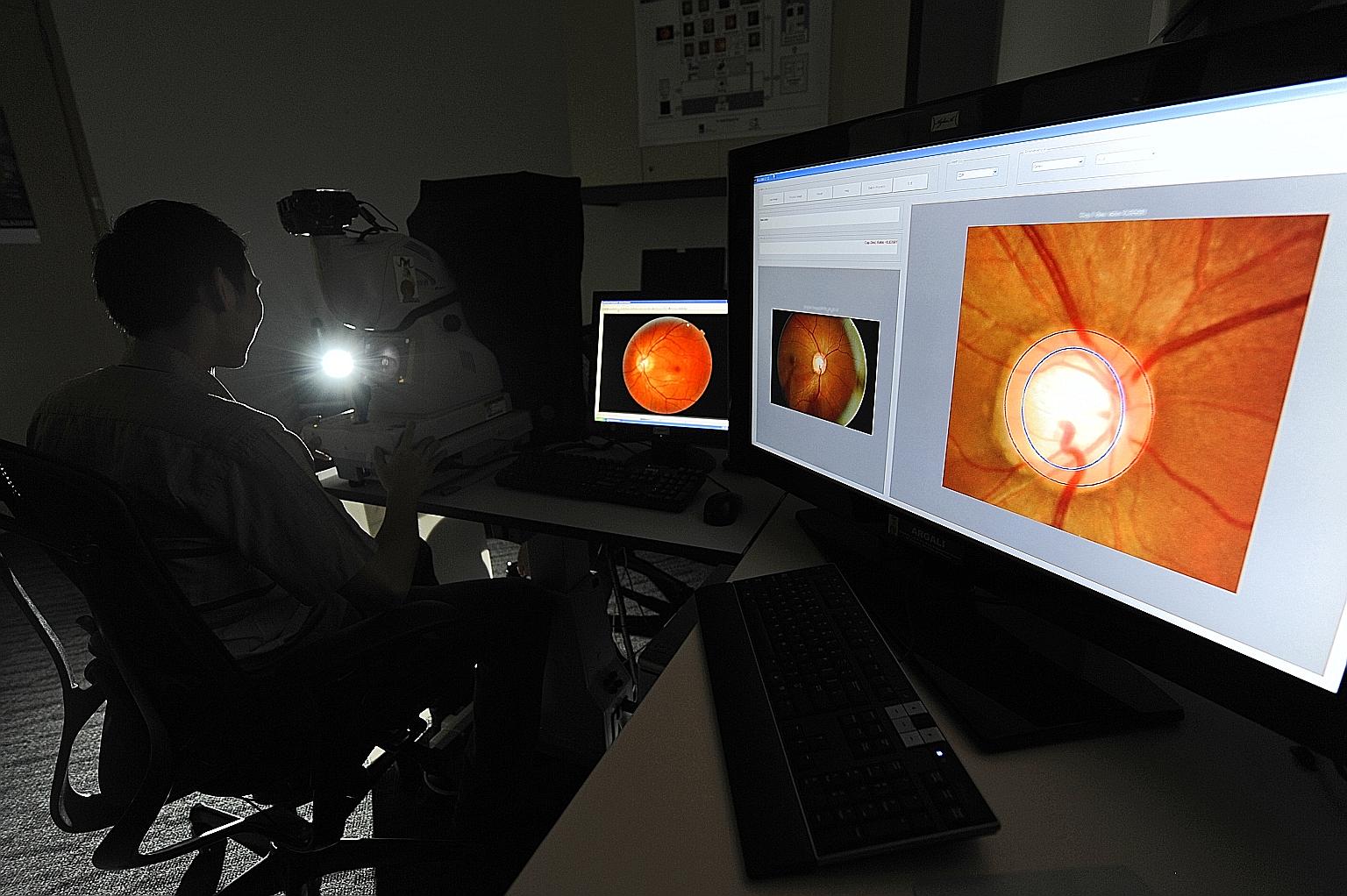Sinseh Says
Black dots in eye after cataract surgery
In TCM, floaters linked to spleen, liver and kidney deficiencies
Sign up now: Get ST's newsletters delivered to your inbox

An eye examination can help detect any problems, such as retinal tears, early. Consult your ophthalmologist immediately if you experience a sudden increase in floaters, light flashes or darkness at the sides of your vision (peripheral vision loss).
ST FILE PHOTO
Follow topic:
Q I am a 60-year-old man who recently had cataract surgery in my right eye. Although my vision is all right, I now see many small black dots (floaters) in my right eye, like many tiny insects flying in front of my face.
The ophthalmologist explained that this is benign, and the brain will adapt to it. Are there any TCM remedies for this?
A Floaters are black spots or lines in one's field of vision that drift with eye movements. They are often described as flies, cobwebs, the letter "C" or strands of hair.
The condition may be caused by age-related vitreous degeneration, inflammation in the back of the eye, bleeding in the eye or a torn retina. Those at an increased risk of developing floaters include people over 50, those who are near-sighted, or have had eye trauma, complications from cataract surgery, diabetic retinopathy or eye inflammation.
In traditional Chinese medicine (TCM), floaters are likely due to deficiencies in the spleen, liver and kidneys.
Or, they could be due to a lack of qi (vital energy) and blood, or poor blood circulation. Sometimes, pathogens like phlegm and dampness may be to blame.

In TCM, the spleen transports and transforms nutrients into qi and blood to nourish the body.
It can be weakened by ageing, a weak constitution, chronic diseases, an unbalanced diet, alcohol consumption and smoking.
When this happens, the spleen will convert the nutrients into phlegm and dampness. Phlegm and dampness then travel along the meridian and reach the eyes.
It then triggers floaters that come with blurred version, flying and dancing dark specks, alongside other symptoms such as a pale or yellowish complexion, poor appetite, lots of phlegm and fatigue.
When phlegm and dampness accumulate in the body over a prolonged period, they create heat.
Heat and dampness travel along the meridian to the eyes and trigger floaters that show up as floating dark shadows and blurred vision.
Other symptoms include a stuffy chest, poor appetite, a bitter mouth, irritability and heaviness of the head.
In TCM, the kidneys manufacture blood and the liver stores it.
If these organs are weakened due to reasons such as ageing, a weak constitution and chronic diseases, they are unable to produce sufficient blood to nourish the eyes. This, in turn, will lead to vitreous degeneration and trigger floaters that come with floating dark specks, or specks that come and go, circles or half-circles, or flashes of light.
These symptoms are developed gradually from other eye diseases. There may also be blurred vision, dry eyes, fatigue, dizziness with tinnitus (ringing in the ears), lower backaches, or dry throat and mouth.
When the kidney yin (responsible for moistening and nourishing the whole body) is deficient - due to ageing, general weakness, chronic diseases and late nights - the body will create internal heat and fire.
This internal heat and fire will go into one's blood and trigger vitreous haemorrhage (bleeding in the eyes), which leads to floaters with dancing dark specks and poor vision.
Other symptoms include dizziness with tinnitus, irritability, insomnia, and dry throat and mouth.
When the liver function is weak, due to reasons such as ageing, negative emotions or insufficient blood, it will affect qi and blood circulation and cause blood stasis (poor blood flow).
Also, a history of eye surgery or previous eye injury which fails to heal completely can cause the blockage of qi and blood, resulting in blood stasis.
Blood stasis in the eyes can trigger floaters with dark specks, sudden poor vision, depression, a stuffy chest, distension in the ribs area and a bitter mouth.
WAYS TO REDUCE FLOATERS
Some ways to ease your problem include consuming Chinese herbal medicine, acupuncture and cupping therapy. They help to strengthen the affected organs and dispel the disease-causing pathogens.
To dispel phlegm and dampness, try dried tangerine peel, Indian bread and largehead atractylodes rhizome.
If you are affected by heat and dampness, take coix seed, cape jasmine fruit and plantain seed.
To strengthen the liver and kidneys, go for common anemarrhena rhizome, amur cork-tree and tree peony bark.
Yerbadetajo herb, lalang grass rhizome and common bletilla tuber are used to boost kidney yin and stop the bleeding in the eyes.
To enhance one's blood circulation and reduce blood stasis, try Chinese angelica, Sichuan lovage rhizome, white peony root and Chinese thorowax root.
If the floaters are due to bleeding in the eyes, the patient should rest in bed, stop smoking and drinking alcohol, and abstain from spicy and oily food in order to reduce his internal heat and dampness.
Some light massage in the areas around the eyes, as well as avoiding negative emotions, such as fear, worry, anxiety and depression, are helpful in enhancing the qi and blood circulation.
Consult your ophthalmologist immediately if you are experiencing any sudden increase in floaters, light flashes or darkness at the sides of your vision (peripheral vision loss). Go for an eye examination in order to pick up retinal tears, with or without retinal detachment.
Lim Lay Beng
Traditional Chinese medicine practitioner at YS Healthcare TCM Clinic
GOT A PROBLEM?
E-mail your question to sthealth@sph.com.sg. Specify Sinseh Says as the subject and include your name, age, gender, identity card number and contact details.

